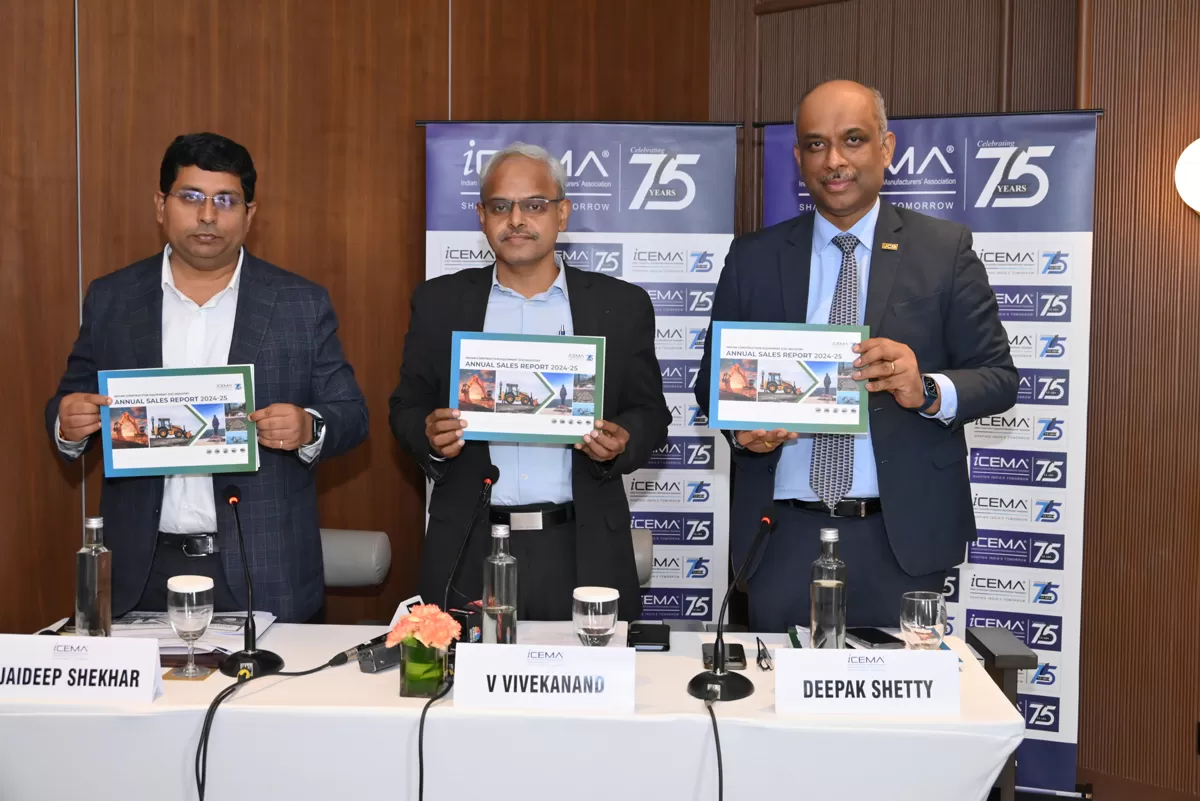The Indian Construction Equipment Manufacturers' Association (ICEMA) today announced that the Indian construction equipment industry achieved a 3 per cent year-on-year growth in FY25, with total equipment sales reaching 1,40,191 units compared to 1,35,650 units in FY24. While domestic market growth remained subdued at 2.7 per cent, the industry's overall performance was better due to a robust 10% surge observed in exports, reinforcing India's position as the world's third-largest construction equipment market.
Vivekanand, President, ICEMA and Managing Director, Caterpillar India, commented: "The 3 per cent growth in FY25 demonstrates the resilience of India's construction equipment industry, particularly in challenging domestic market conditions. While we faced headwinds during the election period that impacted domestic demand, the remarkable 10 per cent surge in exports validates the global competitiveness of Indian-manufactured equipment. This export momentum positions our industry well as we work towards meeting the anticipated higher demand for construction equipment in the coming years."
Key Performance Highlights FY25:
- Total Sales Growth: 3.3 per cent increase to 1,40,191 units (FY24: 1,35,650 units)
- Domestic Sales: Modest 2.7 per cent growth to 1,26,961 units (FY24: 1,23,660 units)
- Export Performance: Significant 10 per cent surge to 13,230 units (FY24: 11,990 units)
- Market Leadership: Major equipment segments recorded growth
- Production Dominance: 98 per cent of construction equipment sold domestically was produced in India
Segment-wise Performance:
Earthmoving Equipment continued to dominate with 71 per cent market share, recording 99,159 units sold (6 per cent growth). Backhoe Loaders led the segment with 53,133 units (54 per cent share), followed by Crawler Excavators at 35,816 units (36 per cent share).
Material Handling Equipment maintained its position as the second-largest segment with 17,050 units, while Concrete Equipment contributed 14,473 units with a 3 per cent growth. Road Construction Equipment achieved 7,002 units, and Material Processing Equipment recorded 2,507 units.
Domestic Market Challenges:
The industry faced subdued domestic market conditions in FY25, with net domestic sales (excluding non-OEM exports) growing by only 2 per cent. The significant 19% rise in non-OEM exports suggests that while total domestic sales appear stable, the underlying domestic demand showed signs of moderation.
Deepak Shetty, President Designate, ICEMA and CEO & Managing Director, JCB India, stated, "FY25 Has been a year of strategic repositioning for our industry due to a variety of reasons. The growth could certainly have been higher as was anticipated earlier during the year, but as an industry, we continue to be hopeful of a strong future in the longer term. Elections, Rising input costs and Emission standards have affected the growth momentum adversely this year. Exports increased by almost 10% in FY25, which somewhat compensated for the subdued domestic demand.
As a nation, India has moved up the rankings of being the fourth largest economy in the world, and it is only natural to continue the focus on infrastructure development going ahead. The industry, as always remains resilient and looks forward to more growth drivers in addition to the Roads and Highway sector to create a stable and sustainable growth pattern. This is essential also to support the manufacturing of these products in India for the Industry to continue with its investments and help in creation of more jobs"
Jaideep Shekhar, Convener, ICEMA Industry Analysis & Insights Panel and VP & Managing. Director - APAC & EMEAR, Terex India commented, "While FY25 presented challenges with subdued domestic growth, the Indian CE industry's adaptability is evident in the strong export performance. The 98 per cent domestic production coupled with growing international demand showcases the maturity and competitiveness of India's construction equipment ecosystem. As we expect higher CE demand going forward, industry collaboration with government will be crucial to address market challenges and capitalize on growth opportunities."
Seema Gupta, Director General, ICEMA, added, "The industry experienced an almost flat domestic growth in FY25, aligning with expectations due to the general elections and implementation of new emission norms. Both events led to demand fluctuations throughout the year. While material handling and material processing segments faced negative growth due to slowdown in end-use sector activities, the overall resilience shown by the industry is commendable. ICEMA remains committed to working closely with industry stakeholders and government to sustain and enhance future growth."
Growth Drivers and Market Dynamics:
Despite domestic market challenges, the industry's export performance was supported by growing international recognition of Indian manufacturing quality, competitive pricing, and expanding global presence. However, domestic demand faced headwinds from extended monsoon seasons, tight financing conditions, raw material availability and price issues, and project execution delays in key sectors like highway construction and rural infrastructure. The industry's ability to pivot towards export markets while maintaining domestic production capabilities demonstrates strategic adaptability in challenging conditions.
Future Outlook and Industry Support Requirements:
Looking ahead, the industry expects higher demand for construction equipment driven by anticipated infrastructure investments and economic recovery. However, to capitalize on this expected growth, the sector will require necessary government support including policy interventions to stimulate domestic demand, facilitate financing access, and address supply chain challenges. The industry's strong export foundation, combined with robust domestic manufacturing capabilities, positions it well to meet future demand provided appropriate support mechanisms are implemented.




















